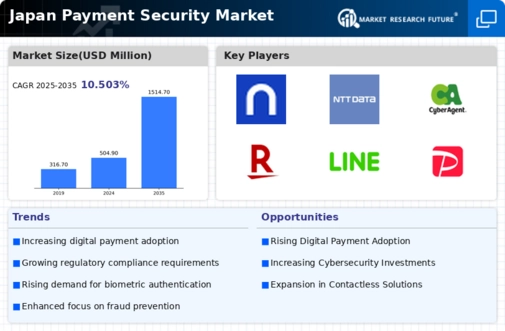Rising Cybersecurity Threats
The increasing frequency and sophistication of cyberattacks in Japan has heightened the demand for robust solutions in the payment security market. In recent years, the nation has witnessed a surge in data breaches and financial fraud incidents, prompting businesses to invest heavily in security measures. According to government reports, the financial sector alone has experienced a 30% rise in cyber incidents, underscoring the urgency for enhanced security protocols. This trend indicates that organizations are prioritizing the implementation of advanced security technologies to safeguard sensitive payment information. As a result, the payment security market is likely to expand as companies seek to mitigate risks associated with cyber threats. This expansion fosters a more secure transaction environment..
E-commerce Growth and Digital Payments
The rapid expansion of e-commerce in Japan has significantly influenced the payment security market. With online retail sales projected to reach ¥20 trillion by 2025, the need for secure payment solutions has become paramount. Consumers increasingly prefer digital payment methods, which necessitates the implementation of stringent security measures to protect against fraud. The rise in mobile payments, which accounted for approximately 40% of all transactions in 2025, further emphasizes the importance of securing payment channels. Consequently, businesses are compelled to adopt advanced security technologies, such as encryption and tokenization, to ensure consumer trust and compliance with industry standards. This dynamic is likely to drive growth in the payment security market as organizations strive to enhance their security frameworks.
Consumer Awareness and Demand for Security
There is a growing awareness among consumers in Japan regarding the importance of payment security, which is shaping the payment security market. As individuals become more informed about potential risks associated with online transactions, they are increasingly demanding secure payment options. Surveys indicate that over 70% of consumers prioritize security features when choosing payment methods. This shift in consumer behavior is prompting businesses to invest in advanced security technologies to meet these expectations. Furthermore, the rise of social media and online reviews has amplified the impact of consumer sentiment on brand reputation, making it essential for companies to demonstrate their commitment to security. As a result, the payment security market is likely to experience growth driven by heightened consumer expectations.
Regulatory Landscape and Compliance Requirements
The regulatory environment in Japan plays a crucial role in shaping the payment security market. With stringent regulations governing data protection and financial transactions, businesses are compelled to comply with these standards to avoid penalties. The Financial Services Agency (FSA) has implemented various guidelines aimed at enhancing security measures within the financial sector. As compliance becomes increasingly complex, organizations are investing in comprehensive security frameworks to ensure adherence to regulations. This trend is likely to drive growth in the payment security market, as companies seek to implement solutions that not only meet regulatory requirements but also enhance their overall security posture. The interplay between regulation and security is expected to continue influencing market dynamics.
Technological Advancements in Security Solutions
The continuous evolution of technology is a key driver in the payment security market. Innovations such as blockchain, artificial intelligence, and machine learning are being integrated into security solutions, enhancing their effectiveness against fraud. In Japan, the adoption of these technologies is gaining momentum, with a reported 25% increase in investments in security technology in 2025. This trend suggests that businesses are recognizing the potential of advanced technologies to provide real-time threat detection and response capabilities. As organizations seek to stay ahead of cyber threats, the payment security market is expected to benefit from the ongoing development and deployment of cutting-edge security solutions, ultimately leading to a more secure payment ecosystem.




















Leave a Comment